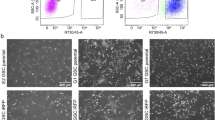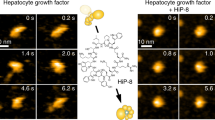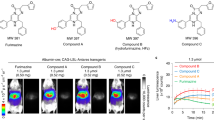Abstract
Tumor necrosis factor-related apoptosis-inducing ligand (TRAIL) has been shown to induce apoptosis in neoplastic cells. While many previous studies have been performed in cell culture, the delivery and efficiency of TRAIL variants in vivo is less well established. Using dual substrate/reporter bioluminescence imaging (Fluc: firefly luciferase – luciferin and Rluc: Renilla luciferase – coelenterazine), we tested the efficacy of TRAIL using replication-deficient herpes simplex virus (HSV) type 1 amplicon vectors in gliomas. The cDNA for complete TRAIL and the extracellular domain of TRAIL (aa 114–281) were cloned into HSV amplicons and packaged into helper virus-free vectors. Both forms of TRAIL induced similar degrees of apoptosis in human glioma cells (Gli36) in culture within 24 h of infection with TRAIL amplicon vectors. Growth of tumors stably transfected with Fluc (Gli36fluc+) was readily monitored in vivo by bioluminescence imaging following luciferin administration. HSV amplicon vectors bearing the genes for TRAIL and Rluc injected directly into Gli36fluc+-expressing subcutaneous gliomas revealed peak Rluc activity 36 h after intratumoral injection as determined by coelenterazine injection followed by imaging. TRAIL-treated gliomas regressed in size over a period of 4 weeks as compared to the mock-injected gliomas. These results show the efficacy of vector delivered TRAIL in treating tumors in vivo and offer a unique way to monitor both gene delivery and efficacy of TRAIL-induced apoptosis in tumors in vivo in real time by dual enzyme substrate (Rluc/Fluc) imaging.
This is a preview of subscription content, access via your institution
Access options
Subscribe to this journal
Receive 50 print issues and online access
$259.00 per year
only $5.18 per issue
Buy this article
- Purchase on Springer Link
- Instant access to full article PDF
Prices may be subject to local taxes which are calculated during checkout





Similar content being viewed by others
Change history
20 February 2024
Editor's note: Readers are alerted that concerns have been raised regarding the reliability of data presented in this article. Further editorial action will be taken if appropriate once the investigation into the concerns is complete and all parties have been given an opportunity to respond in full.
References
Ashkenazi A and Dixit VM . (1998). Science, 281, 1305–1308.
Ashkenazi A and Dixit VM . (1999). Curr. Opin. Cell Biol., 11, 255–260 (Review).
Bhumik S and Gambhir SS . (2002). Proc. Natl. Acad. Sci. USA, 99, 377–382.
Boviatsis EJ, Scharf JM, Chase M, Harrington K, Kowall NW, Breakefield XO and Chiocca EA . (1994). Gene Ther., 1, 323–331.
Chinnaiyan AM, Prasad U, Shankar S, Hamstra DA, Shanaiah M, Chenevert TL, Ross BD and Rehemtulla A . (2000). Proc. Natl. Acad. Sci. USA, 97, 1754–1759.
Contag PR, Olomu IN, Stevenson DK and Contag CH . (1998). Nat. Med., 4, 245–247.
Contag CH and Buchmann MH . (2002). Ann. Rev. Biomed. Eng., 4, 235–260.
Contag CH, Jenkins D, Contag PR and Negrin RS . (2000). Neoplasia, 2, 41–52 (Review).
Di X, Nishizaki T, Harada K, Kajiwara K, Nakayama H and Ito H . (1997). J. Exp. Clin. Cancer Res., 16, 389–394.
Evan S and Littlewood V . (1998). Science, 281, 1317–1322 (Review).
Evan GL, Brown L, Whyte M and Harrington E . (1995). Curr. Opin. Cell Biol., 7, 825–834 (Review).
Fraefel C, Jacoby DR and Breakefield XO . (2000). Adv. Virus Res., 55, 425–452.
Fulci G and Chiocca EA . (2003). Front Bioscience, 8, 346–360 (Review).
Gambhir S . (2002). Nat. Rev. Cancer, 2, 683–693 (Review).
Gliniak B and Le T . (1999). Cancer Res., 59, 6153–6158.
Griffith TS and Broghammer FL . (2001). Mol. Ther., 4, 257–266.
Griffith TS, Anderson RD, Davidson BL, Williams RD and Ratliff TL . (2000). J. Immunol., 165, 2886–2894.
Gruss HJ and Dower SK . (1995). Blood, 85, 3378–3404 (Review).
Jo M, Kim TH, Seol DW, Esplen JE, Dorko K, Billiar TR and Strom SC . (2000). Nat. Med., 6, 564–567.
Kagawa S, He C, Gu J, Koch P, Rha SJ, Roth JA, Curley SA, Stephens LC and Fang B . (2001). Cancer Res., 61, 3330–3338.
Kashima T, Vinters HV and Campagnoni AT . (1995). J. Neuropathol. Exp. Neurol., 54, 23–31.
Lawrence D, Shahrokh Z, Marsters S, Achilles K, Shih D, Mounho B, Hillan K, Totpal K, DeForge L, Schow P, Hooley J, Sherwood S, Pai R, Leung S, Khan L, Gliniak B, Bussiere J, Smith CA, Strom SS, Kelley S, Fox JA, Thomas D and Ashkenazi A . (2001). Nat. Med., 7, 383–385.
LeBlanc HN and Ashkenazi A . (2003). Cell Death Differ., 10, 66–75.
Luker GD, Bardill JP, Prior JL, Pica CM, Piwnica-Worms D and Leib DA . (2002). J. Virol., 76, 12149–12161.
Marsters SA, Pitti RM, Donahue CJ, Ruppert S, Bauer KD and Ashkenazi A . (1996). Curr. Biol., 6, 750–752.
Morgenstern JP and Land H . (1990). Nucleic Acids Res., 18, 3587–3596.
Nagata S . (1997). Cell, 88, 355–365.
Nitsch R, Bechmann I, Deisz RA, Haas D, Lehmann TN, Wendling U and Zipp F . (2000). Lancet, 356, 827–828.
Pitti RM, Marsters SA, Ruppert S, Donahue CJ, Moore A and Ashkenazi A . (1996). J. Biol. Chem., 271, 12687–12690.
Pulkkanen KJ, Parkkinen JJ, Laukkanen JM, Kettunen MI, Tyynela K, Kauppinen RA, Ala-Opas MY and Yla-Herttuala S . (2001). Cancer Gene Ther., 8, 529–536.
Rehemtulla A, Stegman LD, Cardozo SJ, Gupta S, Hall DE, Contag CH and Ross BD . (2000). Neoplasia, 2, 491–495.
Rieger J, Naumann U, Glaser T, Ashkenazi A and Weller M . (1998). FEBS Lett., 427, 124–129.
Saeki Y, Fraefel C, Ichikawa T, Breakefield XO and Chiocca EA . (2001). Mol. Ther., 3, 591–601.
Shen Y and Shenk TE . (1995). Curr. Opin. Genet. Dev., 5, 105–111 (Review).
Tjuvajev JG, Doubrovin M, Akhurst T, Cai S, Balatoni J, Alauddin MM, Finn R, Bornmann W, Thaler H, Conti PS and Blasberg RG . (2002). J. Nucl. Med., 43, 1072–1083.
Vaux DL . (1993). Proc. Natl. Acad. Sci. USA, 90, 786–789 (Review).
Voelkel-Johnson C, King DL and Norris JS . (2002). Cancer Gene Ther., 9, 164–172.
Wajant H, Pfizenmaier K and Scheurich P . (2002). Apoptosis, 7, 449–459.
Walczak H, Miller RE, Ariail K, Gliniak B, Griffith TS, Kubin M, Chin W, Jones J, Woodward A, Le T, Smith C, Smolak P, Goodwin RG, Rauch CT, Schuh JC and Lynch DH . (1999a). Nat. Med., 5, 157–163.
Walczak H, Miller RE, Ariail K, Gliniak B, Griffith TS, Kubin M, Chin W, Jones J, Woodward A, Le T, Smith C, Smolak P, Goodwin RG, Rauch CT, Schuh JC and Lynch DH . (1999b). Nat. Med., 5, 157–163.
Weissleder R . (2002). Nat. Rev. Cancer, 2, 11–18 (Review).
Acknowledgements
We thank Sara Camp for helping with viral DNA preparations and Deb Schuback for interesting discussions. We also thank Dr Edward Graves for providing us with the image analysis program and its regular upgrades and Dr Vasilis Nziachristos for help with the imaging system installation and CCD camera calibration. This work is supported in part by American Brain Tumor Association grant, Gene therapy for brain tumors (GTBT) CA6924 grant, a P50 center grant (CA86355), Goldhirsh Medical Foundation of Massachusetts and small animal imaging resource grant (SAIRG) (R24-CA92782).
Author information
Authors and Affiliations
Corresponding author
Rights and permissions
About this article
Cite this article
Shah, K., Tang, Y., Breakefield, X. et al. Real-time imaging of TRAIL-induced apoptosis of glioma tumors in vivo. Oncogene 22, 6865–6872 (2003). https://doi.org/10.1038/sj.onc.1206748
Received:
Revised:
Accepted:
Published:
Issue Date:
DOI: https://doi.org/10.1038/sj.onc.1206748
Keywords
This article is cited by
-
The role of aquaporin 4 in brain tumors: implications for pathophysiology, diagnosis and therapy
Molecular Biology Reports (2022)
-
Rational design of genetically encoded reporter genes for optical imaging of apoptosis
Apoptosis (2020)
-
Regulating the expression of therapeutic transgenes by controlled intake of dietary essential amino acids
Nature Biotechnology (2016)
-
Antiangiogenic Variant of TSP-1 Targets Tumor Cells in Glioblastomas
Molecular Therapy (2015)
-
Multimechanistic Tumor Targeted Oncolytic Virus Overcomes Resistance in Brain Tumors
Molecular Therapy (2013)



